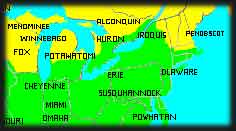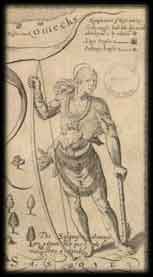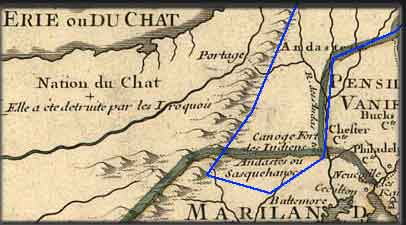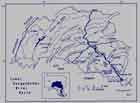*Topic Relevance: The Natives of this region are relevant to both the the Howard and Allied Ascendancy and the Swope and Allied Ascendancy. which together form the genealogical basis for the Within the Vines Website.
*Topic Relevance: The Natives of this region are relevant to both the the Howard and Allied Ascendancy and the Swope and Allied Ascendancy. which together form the genealogical basis for the Within the Vines Website. |
|
They are found referred to as the Susquehannocks, the Andastes, the Minguas, and the Conestogas. Relatively few in number and isolated by their inland location, they managed to become an important trading partner with all of the competing European powers involved in Penna history-an achievement unmatched by any other tribe 6. Iroquoian by language and unconquerable by their native enemy the Iroquois of the League until the mid 17th as a result of related European introduced disease, Wm Penn encountered the Conestoga, their remnant people with whom he sought treaty , on his arrival in 1682, only to understand them recently subjugated to NY's Iroquois League. In the 1720s, the Iroquois League deeded "All land west of the Susquehanna to the Setting Sun" to Penn heirs, thus opening the westward expansion involved in the settlement of Adams County by our European forebears. The remnant Susquehannock people thus saw the land they held so long, amidst and against so many, lost forever. By 1700 there were only 300 Susquehannock. The history of the Susquehannock nation ends with "Conestoga Town" a new town in their ancestral homeland to which some of the original tribe returned as allowed by the Iroquois, located somewhere on the Conestoga river. 6While William Penn himself visited it in 170010, the town was diminuitive, having ever less occupants always peaceful in nature. Their last small band was wiped out by the Paxtang Gang in 1768 Lancaster Co., Pa but their blood continues to run in veins of other Native American descendants with whom this people mingled.
|
Their own name for themselves is lost to history. Apparantly the
Powhatan called the Susquehannocks by the name Pocoughtaonack or Bocootawwanauke.
They were Andaste
to the French, Andastoerrhonon to their friends the Huron and Mingua
to the Swedes and Dutch.
" The
Hurons called them the 'Andastoerrhonons', the French called them the Andasta,
later this name was modified to Andastogas. In Jesuit Relations for 1663
(p. 47)1 they are called Andastogueronnons (using the Huron word)
and are said to live near New
Sweden (the Philadelphia area) which is the first reference to them
in this area although its thought they had been in this area for some time.
The next change in the name is Gandastogas which first appears in Jesuit
Relations for 1667(Mission Du Sault, 1667, p. 153), in this citation
they seem to make a distinction between Gandastogue which is a place name
and Gangdastogues which is the people's name (Jesuit Relations, 1669-1670,
p. 105). The last change in the name is to Conestoga, probably developed
after contact with Europeans. "31.
"On the lower Susquehanna
dwelt the formidable tribe called the Andastes. Fierce and resolute
warriors, they long made head against the Iroquois of New York and were
vanquished at last more by disease than by the tomahawk. They were known
to the Dutch and Swedes as the Mingoes; the Marylanders as the Susquehannocks,
and
To Top of Page and Page Table of Contents
|
 |
|
B) Susquehannock
Pre Contact Numbers, Region of Habitation and Influence:
The Susquehannocks,
an Iroquoian
speaking group in an Algonquian
region, were a physically large people & the dominant tribe
between 5-7000 in 1600. The Suquehannock " had a formidable village in the lower [Susquehanna] river valley near present-day Lancaster, Pennsylvania, when Captain Smith met them. He estimated the population of their village to be two thousand, although he never visited it. Modern estimates of their population, including the whole territory in 1600, range as high as seven thousand." 10 |
| C)
Susquehannock History to 1656:
Historically
the Susquehannocks were allies of the Iroquoian language affiliated
Huron and enemies , like the Huron , of the Iroquoian language affiliated
Iroquois Confederacy found at the north border to the Susquehannocks
ancestral homeland. Since the Susquehannock apparently had been good friends
with the Huron from times long before contact, it is possible they migrated
to the Susquehanna Valley from the north. 7
"The earliest village sites identified as Susquehannock were located on the upper Susquehanna River and date from about 1550, but they probably had occupied the region for at least 400 years before this. Although they inflicted a major defeat on the Mohawk [of the Iroquois Confederacy] shortly before 1600, wars with the Iroquois Confederacy had forced the Susquehannock south into the lower Susquehanna Valley by 1570."6"Hardened by years of constant warfare, [the Susquehannock] overwhelmed the Algonqui[a]n tribes along the shores of the Chesapeake Bay and began extending their control southward." 6 |

Post Contact Map of Native American
settlement ca 1500 |

Cartouche of Susquehannock from Smith's map |
Little
is known of the Susquehannock culture. First European contact was
by John Smith in 1608 while he was exploring the north of Chesapeake Bay,
but Smith did not visit their villages. In 1615 France's Brulé
explored the area south of the Huron homeland and crossed the the
Niagara River, reaching the Susquehannock villages on the upper Susquehanna
River, where he discovered the Susquehannock were more than willing to
ally themselves with the French and Huron in their war against the
Iroquois League." 6 It was not until they
had been decimated by epidemic and wars with other natives that their villages
were visited by other Europeans, leaving Susquehannock description incomplete.
Smith's contact with
the Susquehannock in 1608 "was friendly enough, but Smith was
wary because of their reputation and awed by their size. His later reports
described them as giants."6 The name by which
we know these people and their river comes from Smith's Alqonquian interpreter
who called them People at the Falls, or People of the Muddy River.
The Susquehannock
were soon trading with the English in Virginia, pushing aside the
Powhatan and their Confederacy8 The
Atlantic Coast Tribes engaged in warfare in the 1600s over the right to
trade the Dutch and
the
Swedes, both of whom were trading partners of the Susquehannock. Owing
to Susquehannock willingness to fight with the
French against the Iroquois League, [ see
footnote two : The French and the Susquehannock] the Susquehannock
had succesful trade with that Colonial Power as well. The Susquehannock
were the only nation in the state of now Pennsylvania who had succesful
trade with all
four of the colonial powers involved in Penna history. See the
succinct description of Susquehannock trading relationships with
the European powers in Footnote Two below.
|
|
from their only possible ally, and exposing the Erie to their subsequent destruction by the Iroquois League. The Susquehannock meanwhile subjugated the Lenni Lenape/ Delaware [an Algonquian language people] while by 1656 the Iroquois of the League had conquered and assimilated their Iroquioan-speaking rivals except the Susquehannock , starting at this time to clear the Algonquian tribes from the Ohio Valley and lower Michigan but as yet not dominating the Susquehannocks or the Lenni Lenape/ Delaware over whom the Susquehannocks held dominion. It was the introduction of European disease which was to prove the demise of the mighty Susquehannock, leading to their subjugation by the powerful Iroquois League which had been unable to subjugate them through warfare alone. William Penn, in seeking a treaty with the Susquehannock in 1683, found that this nation was subservient to the Iroquois of the League, just as were the Lenni Lenape/ Delaware over which the Susquehannocks themselves had held dominion 40 some years before. To Footnotes Referred to in above On to Penn's Arrival and the Susquehannock To Top of Page and Page Table of Contents |
Footnotes : Footnote
One: The Eries in Brief
The Erie, or Cat Nation, belonged to the Iroquoian linguistic group, lived in central and western Pennsylania, New York State as far east as the Genesee River31, and in Ohio along the shore of Lake Erie as far west as the Maumee River31. In 1655 the Iroquois of New York State "destroyed the Erie Nation. The Iroquois had the advantage of guns, provided by the English and Dutch settlers in the East, and those Eries who could not escape to the West were killed or captured. For fifty years after that massacre no Indians dared migrate into the Ohio country. These same New York Indians in 1649 invaded Ontario, driving out the Hurons, who eventually moved into the Maumee Valley, where they became known as the Wyandots." 32 Footnote Two: The Susquehannock and Their Trade with the Colonial Powers Background: The French had early emnified
the Iroquois of the Confederacy.
On to Penn's Arrival and the Susquehannock To Top of Page and Page Table of Contents |
| D) Penn's Arrival and The Susquehannock: |
 |
By the time of Penn's
arrival in Pennsylvania, the Susquehannock had been greatly reduced by
epidemic and war-they were subjugated by the Iroquois
Confederacy, and the Susquehannock former vassals, the Delaware
and
Munsee Indians, were subjugated along with
them.
"In 1683 William Penn attempted to sign a treaty with them [ed note, the susquehannock] only to learn that the Susquehannock (like the Delaware) first needed Iroquois approval to sign. Subsequent dealings by the Pennsylvania government concentrated on the Iroquois and ignored the subservient tribes. The Iroquois eventually allowed 300 Susquehannock to return to the Susquehanna Valley in Pennsylvania. No longer a powerful people, they became known as the Conestoga (from the name of their village). The Iroquois kept a watchful eye on them and used their homeland as a kind of supervised reservation for the displaced Algonqui[a]n and Siouan tribes (Delaware, Munsee, Nanticoke, Conoy, Tutelo, Saponi, Mahican, Shawnee, and New England Algonqui[a]n) who were allowed to settle there as members of the 'covenant chain.' " 6 |
| Above: Post Penn Arrival [1782] French Map
of the Susquehannock Territory Map to Right: Region of Influence Pre Contact
|
| E) The End of the Susquehannock Nation: |

Above is the Map detailing the Conestoga River on which the Conestoga Settlement existed, the exact location of which is not known. This was the last abode of the last full blooded descendants of the Susquehannock. Click image for enlargement |
By 1700 there were
only 300 Susquehannock. The history of the Susquehannock nation ends with
"Conestoga Town" a new town in their ancestral homeland to which
some of the original tribe returned as allowed by the Iroquois, located
somewhere on the Conestoga river. 6While
William Penn himself visited it in 170010,
the town was diminuitive, having ever less occupants always peaceful in
nature. But Indian uprisings in the Great Lakes region relevant to Pontiac's
War erupted into acts of great violence and rage against these now docile
remnants of a once fierce people in south central Pennsylvania. As feelings
rose, fourteen Conestoga were arrested and placed in the jail at Lancaster,
Lancaster County, Penna., for their own protection. In 1763, the
Paxton boys murdered the six people they found in the settlement6
, 10and within weeks proceeded to
the jail where the beat the remaining to death6.
Two survivors , not present at the time of the attacks and named Michael
and Mary , were later protected by the Gov, but when they died, the Susquehannock
nation died with them.6. Descendants, however,
are felt to exist among the Delaware, Tuscarora,
Oneida [of the Iroquois League], and Oklahoma
Seneca [of the Iroquois League] peoples.6
Detailed
history on the Susquehannock can be found at Susquehannock
History while more information is found at BrokenClaw.com's
Where
are the Susquehannock now?
|
| Sources
for This Page:
1. State Museum of Pennsylvania. Brief Summary of the 1681 Charter. 2. From York County History Pages of York County Webpages. 3. Penn and the Indians page of site entitled " William Penn. Visionary Proprietor" by Tuomi J. Forrest 4 Indians, Sources, Critics by Will J. Alpern (Prudential-Bache Securities). Presented at the 5th Cooper Seminar, James Fenimore Cooper: His Country and His Art at the State University of New York College at Oneonta, July, 1984. ©1985 by State University of New York College at Oneonta ["may be downloaded and reproduced for personal or instructional use, or by libraries" ] Originally published in James Fenimore Cooper: His Country and His Art, Papers from the 1984 Conference at State University of New York College -- Oneonta and Cooperstown. George A. Test, editor. (pp. 25-33) 5. Kittanning-pa.com 6. SUSQUEHANNOCK HISTORYpart of First Nations, Issues of Conesquence pages. Lee Sultzman 7. SUSQUEHANNOCK HISTORY, Lee Sultzman. Part of First Nations Histories 8.Information on the Susquehannock Indians from Pagewise 9. Delaware History by Lee Sultzman.. Part of First Nations Histories 10. Where are the Susquehannock now? part of the pages of BrokenClaw.com 12. Native Americans Post Contact:, from The Mariners Museum, Newport News, Va pages 13. Internet School Library Media Center, Monacan Indians page. 14. AN AMERICAN SYNTHESIS The Sons of St. Tammany or Columbian Order . [ the footnotes evident in the text takent from "an American Synthesis" can be accessed at the link given in source 15. Iroquois . By: Joe Wagner, with references provided. 16. The Iroquois. by Lee Sultzman. Part of First Nations Histories 17 William Henry Harrison and the West , part of Dr James B. Calvert's pages at University of Denver Website. At the time of Penn's arrival in 1682, the Susquehannock were subservient to the Iroquois Confederacy, just as their enemies and neighbors, the Delaware , were. The Susquehannock were decimated by war and disease, but the Lenape remained vital. 18. Shawnee's Reservation a detailed site on Shawnee History 19. Shawnee History by Lee Sultzman. . Part of First Nations Histories 20. Marjorie Hudson, Among the Tuscarora: The Strange and Mysterious Death of John Lawson, Gentleman, Explorer, and Writer, North Carolina Literary Review, 1992 [transcribed at East North Carolina Digital History Exhibits] 21. Chief Logan: Friend, Foe or Fiction? by Ronald R. Wenning. The Journal of the Lycoming County Historical Society, Volume XXXVII, Number 1, Fall, 1997 22. Mingo Indians part of The Allegheny Regional Family History Society's Web pages 23. Weiser, Shikellamy and the Walking Purchase By Al Zagofsky 24. Conrad
Weiser from the Pennsylvania Historical and Museum Commission
|
|
To Natives of Pa Mainpage To Natives Americans of now US Mainpage |

Email Webmistress |
To Our American Immigrants To Within The Vines Home |